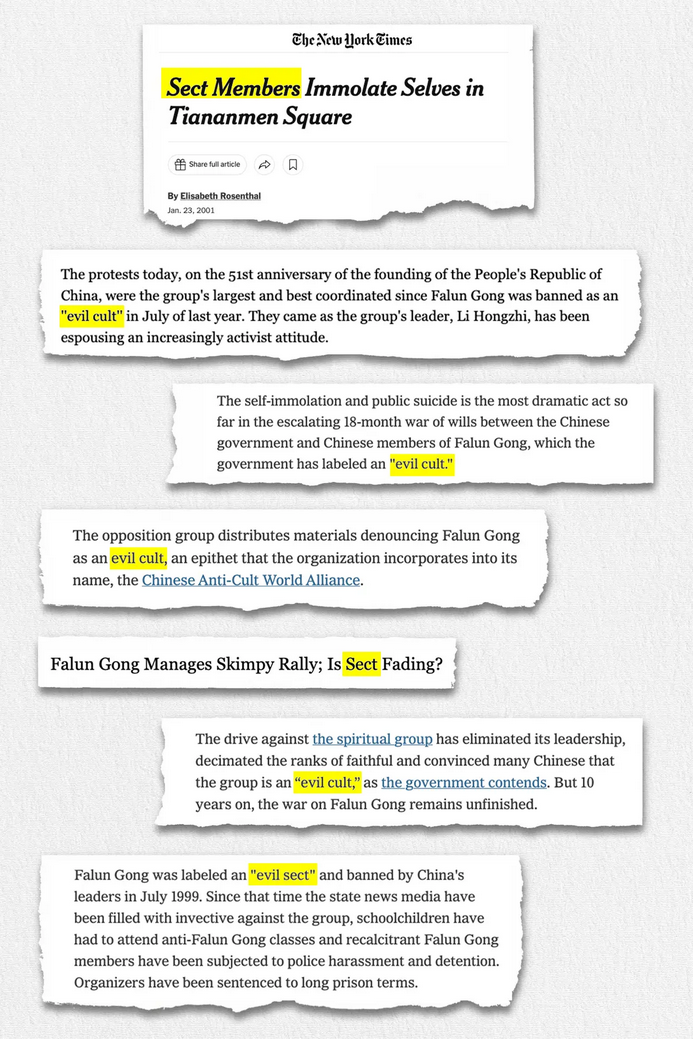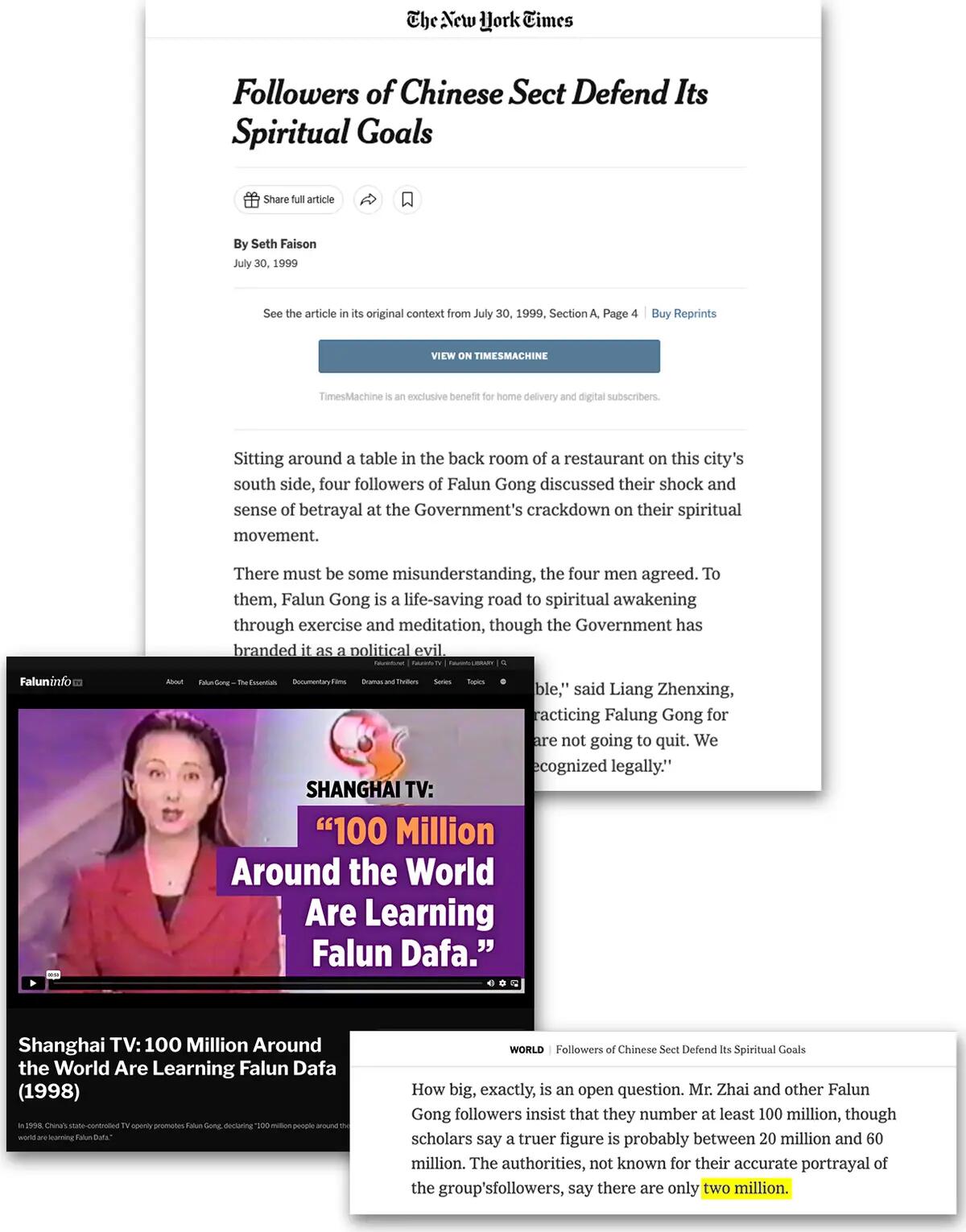New York Times' 'Distorted' Coverage Of CCP Abuses Likely Cost Lives, Report Says
Authored by Petr Svab via The Epoch Times (emphasis ours),
Updated August 18, 2024
At critical moments over the past 25 years, The New York Times has aided the interests of a power faction within the Chinese Communist Party responsible for atrocities against practitioners of the spiritual discipline Falun Gong.
On top of implicating itself ethically, the paper has also, as a result, distorted its China coverage and misled its readers, as revealed by an analysis of The New York Times’ China coverage as well as interviews with half a dozen experts on Chinese Communist Party (CCP) politics and geopolitics.
Due to the paper’s disproportionate influence on policy, its skewed coverage has likely led to a loss of life and treasure that is difficult to quantify, some experts said.
The New York Times has for decades positioned itself as a global newspaper, insisting on the necessity of access to China, according to former staffers. That meant convincing the communist regime that the paper’s presence would benefit it.
The paper has never explained what price it has paid for access to the country.
“There’s always the issue of, if you want to be a global newspaper, what do you have to do to keep China happy and stay in business there?” Tom Kuntz, a former editor at the paper, told The Epoch Times.
“There’s always been tensions, and I know they’ve, like a lot of companies, tried to maintain access to China.”
Bradley Thayer, a former senior fellow at the Center for Security Policy, expert on strategic assessment of China, and a contributor to The Epoch Times, was more blunt.
“If they don’t cover the regime the way the regime wants to be covered, they’re going to be blackballed. They’re not going to be able to return,” he told The Epoch Times.
“So all of these individuals have a vested interest, if you will, in toeing the Party line.”
Covering Chinese politics, The New York Times has ascribed sincerity where deception is expected and glossed over where it should have dug deeper, all in a pattern of affinity with the interests of a CCP clique aligned with former Party leader Jiang Zemin, multiple experts affirmed.
The New York Times did not respond to a detailed list of questions sent via email.
Privileged Position
The paper developed a special connection with Jiang in 2001, when its then-publisher, Arthur Sulzberger Jr., and several editors and reporters were granted a rare audience with the dictator.
The paper ran an exclusive interview headlined “In Jiang’s Words: ‘I Hope the Western World Can Understand China Better.’”
Within days, the CCP unblocked access to The New York Times’ website in China.
A month later, the CCP unblocked several other Western news sites, including those of The Washington Post, the Los Angeles Times, the San Francisco Chronicle, and the BBC. The sites were blocked again within a week.
The New York Times, on the other hand, remained accessible. Users reported that content on the site was being blocked selectively.
The interview came at a sensitive time for Jiang. He had only a little more than a year left before he was supposed to hand over Party control to Hu Jintao, fulfilling the succession line stipulated by Deng Xiaoping, his predecessor.
But things weren’t going well for Jiang. His persecution of the spiritual practice Falun Gong, a political campaign that was supposed to whip the Party and the nation into conformity under his control, was failing to reach its goals. Even worse, foreign media, including The Wall Street Journal and The Washington Post, were taking apart the CCP’s anti-Falun Gong propaganda and highlighting accounts of wrongful detention and torture.
The New York Times, by contrast, appeared most helpful to Jiang’s campaign. By the time of the 2001 interview, the paper ran several dozen articles on Falun Gong, almost all of them repeating propaganda portraying the practice as a “cult” or a “sect.”
Falun Gong, also known as Falun Dafa, is a spiritual discipline consisting of slow-moving exercises and teachings based on the principles of truthfulness, compassion, and tolerance. It was introduced to the public in China in 1992, and by the end of the decade, an estimated 70 million to 100 million people were practicing it.

By 2001, the New York Times had run several dozen articles parroting CCP propaganda portraying Falun Gong as a “cult” or a “sect.” Screenshots via The Epoch Times, New York Times
When in January 2001 CCP state media claimed that several people who set themselves on fire on Tiananmen Square in Beijing were Falun Gong practitioners, The Washington Post dispatched a reporter to fact-check the story. The New York Times, on the other hand, immediately took the CCP line as fact.
If the paper had employed its much-touted investigative acumen, it would have discovered, as others have, that the self-immolation incident was staged. After the first man allegedly set himself alight in the middle of the square, four policemen managed to obtain several fire extinguishers, rush to the scene, and put out the fire, all in under a minute.
Given the distances involved on the giant square, that wouldn’t have been physically possible—unless the officers already had the fire extinguishers ready and knew in advance where on the square they would be needed that day, several independent investigations concluded, pointing out dozens of other inconsistencies.
Even without any investigation, the incident made little sense. According to the CCP, the victims were supposedly following a belief that burning themselves alive would bring them to heaven. But Falun Gong includes no such belief; its literature treats suicide as killing a human life, which it explicitly prohibits. In fact, of the tens of millions of people practicing Falun Gong, none were said to have publicly set themselves on fire until that day, and none have done so since.
Even after The Washington Post investigation traced several of the alleged victims back to their hometown and found that none had ever been seen practicing Falun Gong, The New York Times continued to spread the CCP’s propaganda.
Jiang was apparently pleased with The New York Times, calling it “a very good paper” during the 2001 interview.
Getting in Jiang’s good graces on the Falun Gong issue would have been particularly critical, as it struck at the heart of a core principle of CCP politics, several experts affirmed.
Shoring Up a Dictator’s Legacy
By 2002, The New York Times was in pro-Jiang mode. Citing CCP sources, the paper declared that Falun Gong had been successfully “crushed.” It suggested that Falun Gong was already passé and that it only ever had 2 million practitioners, going so far as to claim that the figure cited by Falun Gong sources, 100 million, was baseless.
Yet a few years earlier, before the persecution began, multiple Western and Chinese media, including The Associated Press and The New York Times, provided figures of 70 million or 100 million, generally attributing them to estimates by the Chinese State Sports Administration, which had the best insight due to a massive survey of Falun Gong practitioners it conducted in the late 1990s.

The New York Times, citing CCP sources, reported that Falun Gong only ever had 2 million followers. However, multiple Western and Chinese media had reported a figure of 70 million or 100 million before the persecution against Falun Gong began in 1999. In 1998, China’s state-controlled Shanghai TV promoted Falun Gong, declaring that “100 million people around the world are learning Falun Dafa.” Screenshots via The Epoch Times, New York Times, Falun Dafa Information Center
Meanwhile, the paper was portraying Jiang’s legacy as one of a friendly reformer who ushered China onto the world stage.
“Mr. Jiang is, in Chinese terms, deeply pro-American,” declared a 2002 op-ed by one of the paper’s regular contributors.
Despite its past transgressions, China was “becoming more open, tolerant and important,” it said. Jiang’s decision to hold onto the top post in the CCP military past his 2002 retirement was portrayed by the paper as a somewhat controversial sign of strength.
The paper even ran a story about Chinese people making pilgrimages to Jiang’s hometown to study how the local milieu “nurtured” the future leader of the nation. Delving deep into Jiang’s family history, the article omitted a fact most sensitive to Jiang: that his father was a propaganda official in the Japanese-installed puppet government during World War II, and thus a traitor in Chinese eyes.
Bloated Security State
In its coverage, The New York Times failed to catch the full significance of Jiang’s expansion of the Politburo Standing Committee, the body that officially rules the country, from seven to nine members. The move allowed him to add his propaganda chief, Li Changchun, as well as his head of the Political and Legal Affairs Commission (PLAC), Luo Gan.
Under Jiang, the PLAC grew into an all-powerful behemoth controlling the entire national security apparatus. A major part of the reason was, again, the Falun Gong persecution campaign. Because Falun Gong was never officially outlawed in China, Jiang set up an extralegal police organization, called the 610 Office, to carry out the persecution. He put Luo in charge, giving him carte blanche to use whatever resources of the security apparatus needed to “eradicate” Falun Gong.
But Falun Gong was unlike any other group the regime had sought to crush. The usual tactics of rounding up leaders proved ineffective. Save for the practice’s founder, who was already exiled in the United States, Falun Gong lacked formal leaders or a hierarchy. Its local “coordinators” facilitated simple activities such as group exercises. When arrested, others easily picked up their roles.
As the persecution escalated, Falun Gong practitioners ceased to organize public activities in China and focused instead on “clarifying the truth”—explaining the facts about Falun Gong and the persecution individually from person to person. To disrupt their activities, the CCP’s security apparatus had to identify them, surveil them, and arrest them one by one—an immensely resource-intensive process.
The persecution required a massive expansion of the country’s police and surveillance apparatus, which was undertaken by Luo and his successor, Zhou Yongkang, who was also a close associate of Jiang, several analysts said.
China’s legal system, still in its infancy, was strangled in the cradle by the Falun Gong persecution, according to Heng.
“They had to make an exception: Every established law must be [applied as if including] ‘except [for] Falun Gong,’” he said.
Typically, Falun Gong practitioners would be put on trial for “undermining the implementation of the law,” with the statute interpreted so broadly as to capture anything the regime found worthy of suppression, he said.
“The legal system got used to it. And they wouldn’t stop there. They would use this technique to extend their power to other people,” Heng said.
“That’s why China has never been able to establish a real legal system.”
Read more here...
NEVER MISS THE NEWS THAT MATTERS MOST
ZEROHEDGE DIRECTLY TO YOUR INBOX
Receive a daily recap featuring a curated list of must-read stories.




